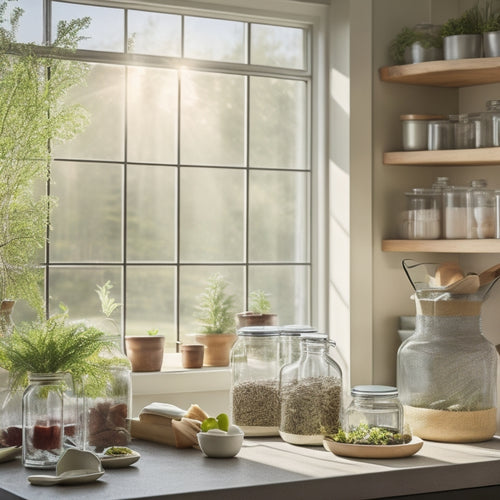
Solar Energy System Cost
Share
You can expect to invest between $15,000 and $30,000 in a solar energy system, depending on the size and complexity of the installation. Factors like panel efficiency, inverter technology, and roof considerations greatly impact costs. For instance, high-efficiency panels and advanced inverters can increase upfront costs but lead to higher energy conversion rates and long-term savings. Assessment of your roof's shading patterns and material integrity is also essential in determining the overall system cost. As you investigate solar energy systems, you'll identify how optimizing these factors can help you achieve a sustainable future and maximize your return on investment.
The Essentials
- Solar energy systems provide long-term savings, with a notable return on investment and financial freedom through reduced monthly energy costs.
- Solar incentives, including tax credits and local incentives, offset installation costs and ease upfront financial burdens.
- Fixed energy rates for 25 years protect against rising energy costs and fluctuations in electricity prices.
- Financing options for solar systems provide flexibility and affordability, making the transition to solar more accessible.
- The cost of solar energy systems varies depending on factors like system size, installation complexity, and local labor costs.
Zero Carbon Footprint Guaranteed
You're likely interested in achieving carbon neutral living, and a solar energy system can guarantee just that.
By utilizing the power of the sun, you'll be relying on an eco-friendly energy source that produces no emissions or pollution.
As the world shifts towards Renewable Power Solutions, it's crucial to evaluate the benefits of solar energy in reducing our reliance on fossil fuels.
Carbon Neutral Living
As the world shifts towards a more sustainable future, embracing carbon neutral living becomes an increasingly vital aspect of reducing our ecological footprint. By adopting a sustainable lifestyle, you're not only contributing to climate action but also ensuring a healthier environment for future generations.
Renewable resources, such as solar energy, play a significant role in achieving energy independence and reducing our reliance on fossil fuels. Many businesses have already made the switch to commercial solar solutions, which address key pain points such as skyrocketing energy bills and limited flexibility and energy independence.
Incorporating green technology into your daily life is a meaningful step towards eco-conscious choices. This includes investing in energy-efficient appliances, reducing water consumption, and conserving resources. By making these changes, you're taking charge of your environmental stewardship and promoting a cleaner, healthier environment.
With carbon neutral living, you'll enjoy the freedom of having a clear conscience, knowing you're doing your part to combat climate change. You'll breathe easier, literally, with the clean air that comes from reducing your carbon footprint.
Eco-Friendly Energy Source
How can you guarantee a reliable and consistent energy supply while maintaining a zero-carbon footprint?
By investing in an eco-friendly energy source, you can secure a sustainable future without compromising on your energy needs. Renewable technologies, such as solar energy systems, offer a viable solution to reduce your carbon footprint.
With the integration of Power Storage and solar panel inverters, you can tackle the issues of high energy bills and limited power supply.
With solar incentives, such as tax credits and rebates, you can offset the initial cost of installation, making it a more affordable option.
Lower Your Energy Bills
You can considerably cut energy expenses by switching to a solar energy system, which translates to reduced monthly costs.
By capturing free energy from the sun, you'll reduce your reliance on the grid and lower your energy bills, making your home more eco-friendly homes and energy efficient.
This approach not only saves you money but also contributes to a cleaner environment by utilizing renewable energy(https://www.illchanter.com).
This can lead to substantial savings over time, providing a notable return on your investment.
Cut Energy Expenses
Solar panels slash your energy expenses by offsetting your reliance on the grid, translating to significant long-term savings. By utilizing the power of the sun, you can reduce your energy consumption from traditional sources, leading to lower utility bills.
With solar panels, you can lock in a fixed energy rate for the next 25 years or more, protecting you from rising energy costs. This means you'll have more control over your energy expenses, giving you the freedom to allocate your resources as you see fit.
To maximize your energy savings, consider pairing your solar energy system with energy efficiency upgrades. This can include improvements like insulation, windows, and appliances that reduce your overall energy consumption.
By combining these upgrades with solar panel financing options, you can create an extensive energy strategy that minimizes your reliance on the grid and saves you money in the long run.
Reduce Monthly Costs
By integrating a solar energy system into your daily life, the immediate benefit of reducing your monthly energy bills becomes a welcome reality.
You'll generate your own clean energy, relying less on the grid, and watching your energy expenses dwindle. This reduction in energy costs can be considerable, especially for those who consume a lot of power. With solar energy, you can lock in a fixed energy rate for the next 25 years or more, shielding yourself from rising electricity prices.
To make the shift to solar even more appealing, there are various solar incentives and financing options available.
You may be eligible for federal tax credits, state rebates, or local incentives that can greatly offset the upfront cost of your solar energy system. Additionally, financing options like loans, leases, or power purchase agreements can provide you with the flexibility to go solar without breaking the bank.
Inverter Maximizes Energy Output
You'll want to make certain your solar energy system is equipped with an inverter that optimizes energy harvesting, as it directly impacts your overall energy output.
By integrating renewable energy storage solutions, you can further maximize your energy yield and reduce your reliance on utility bills.
By converting DC power from your solar panels to AC power for your home, an efficient inverter minimizes energy losses and maximizes your energy yield.
With an inverter that efficiently converts power, you can rest assured you're getting the most out of your solar energy system.
Optimal Energy Harvesting
The inverter plays an essential role in maximizing energy output from your solar panel array, as it converts the DC power generated by the panels into usable AC power for your home or business. To achieve peak energy harvesting, you need to take into account various factors that impact the performance of your solar energy system.
| Optimization Factor | Description |
|---|---|
| Solar Panel Placement | Proper placement of solar panels guarantees maximum exposure to sunlight, reducing energy losses and increasing overall energy output. |
| Energy Storage Options | Integrating energy storage solutions, such as batteries, allows you to store excess energy generated during the day for use during periods of low energy production or at night. |
| Inverter Efficiency | Selecting a high-efficiency inverter assures that the maximum amount of energy is extracted from your solar panel array and converted into usable power. |
Efficient Power Conversion
Efficient power conversion is essential to maximize energy output from your solar panel array, and a high-performance inverter is the key to releasing this potential. This critical component converts the DC power generated by your solar panels into AC power, which is usable in your home or business. A high-efficiency inverter guarantees that you get the most out of your solar energy system, reducing energy losses and maximizing your return on investment.
When selecting an inverter, look for power electronics with high energy efficiency ratings. A higher efficiency rating means more of the sun's energy is converted into usable power, and less is wasted as heat.
Advanced inverters also feature advanced monitoring capabilities, allowing you to track your energy production and identify opportunities for improvement. By choosing an inverter with state-of-the-art power electronics, you can access the full potential of your solar energy system and enjoy greater energy independence.
With efficient power conversion, you'll be generating clean, renewable energy and reducing your reliance on the grid.
Assess Your Roof's Shading
You'll need to assess your roof's shading to guarantee the best solar energy system performance.
Take into account obstacles like skylights, vents, and chimneys that can cast shadows on your solar panels and reduce energy output.
When designing a residential solar power system with integrated energy storage solutions, it's crucial to evaluate the impact of shading on your energy storage capacity, such as Tesla Powerwall systems.
A shading pattern analysis will help you identify the best panel placement to minimize energy losses.
Roof Obstacles to Consider
When evaluating your roof's shading, various obstacles can greatly impact the performance and cost of your solar energy system. You'll need to evaluate the type of roof materials you have, as some may require special installation considerations or additional hardware.
Installation challenges, such as steep or complex rooflines, can increase labor costs and affect system performance. Verify your roof's structural integrity can support the added weight of solar panels, and factor in maintenance requirements, like cleaning and repair access.
The orientation of your roof also impacts energy production, so evaluate weather patterns and potential shading from surrounding trees or structures. Aesthetic concerns, like panel color and placement, may influence your system design.
Research local regulations and permits required for installation, as well as financial incentives that may offset costs. Finally, assess the long-term durability of your roof and how it may affect the lifespan of your solar energy system.
Shading Pattern Analysis
Most roofs exhibit unique shading patterns, which can greatly impact the performance of your solar energy system. As you consider installing solar panels, it's important to conduct a shading analysis to identify areas that may hinder energy production.
This analysis involves evaluating your roof's shading patterns, considering factors like tree coverage, nearby buildings, and roof obstructions.
You'll want to identify the duration and intensity of shading throughout the day. This information will help you determine the best placement of your solar panels to maximize energy output.
Even partial shading can notably reduce solar performance, so it's vital to get an accurate evaluation. A thorough shading analysis will provide you with a detailed map of your roof's shading patterns, enabling you to make informed decisions about your solar energy system's design and installation.
Higher Energy Conversion Rate
You'll want to maximize your solar energy system's energy conversion rate by selecting efficient solar panels.
These panels boast higher power output ratings, ensuring you generate more electricity per unit area.
Efficient Solar Panels
Within the domain of solar energy systems, efficient solar panels play an essential role in capturing the sun's power. You want to maximize the energy conversion rate to get the most out of your solar energy system. This is where efficient solar panels come in. They're designed to convert sunlight into electrical energy with minimal loss. Advances in solar panel technology have led to significant improvements in panel efficiency.
| Solar Panel Type | Panel Efficiency |
|---|---|
| Monocrystalline Silicon | 20-22% |
| Polycrystalline Silicon | 15-18% |
| Thin-Film | 7-14% |
| Bifacial | 20-24% |
| Perovskite | 23-25% |
When selecting efficient solar panels, you'll want to take into account the type of panel that suits your needs. Monocrystalline silicon panels offer high efficiency but at a higher cost. Polycrystalline silicon panels are a more affordable option with slightly lower efficiency. Thin-film panels are budget-friendly but have lower efficiency. Bifacial and perovskite panels offer high efficiency and are gaining popularity. By choosing the right efficient solar panels, you can increase your energy conversion rate and reduce your reliance on traditional energy sources.
Frequently Asked Questions
How Long Does a Solar Energy System Last?
You can expect your solar energy system to last around 25-30 years, with some solar panels lasting up to 40 years, depending on their quality and your maintenance efforts, which should include regular cleaning and inspections.
Can I Install a Solar Energy System Myself?
You can attempt a DIY installation, but consider the risks: improper connections can lead to electrical shock, fire hazards, and invalidating your warranty. Make certain you follow strict Solar panel safety guidelines to avoid accidents and guarantee a safe, efficient system.
What Happens to Excess Energy Generated?
When you generate excess energy, you can employ net metering benefits, feeding it back into the grid and offsetting your future consumption. Alternatively, you can investigate energy storage options, like batteries, to store and use the excess energy when needed.
Do Solar Panels Work on Cloudy Days?
Carefully crafting cloudy outcomes, you'll find solar panels still produce power, albeit reduced, on overcast days, as solar efficiency decreases by up to 50% in cloudy weather, yet still generating some electricity, giving you freedom from fossil fuels.
Are Solar Energy Systems Scalable?
You'll find that solar energy systems are scalable, allowing you to expand or modify your setup as needed, with various installation options available to optimize solar panel efficiency, giving you the freedom to tailor your energy independence.
Final Thoughts
As you flip the switch on your solar energy system, imagine the sweet sound of silence - no carbon footprint, no energy bill anxiety. Your inverter hums along, maximizing energy output like a precision-crafted timepiece. With a thorough assessment of your roof's shading, you're capturing the power of the sun like a 21st-century alchemist, converting photons into electricity at an impressive rate. Your wallet and the planet will thank you - it's a bright future ahead.
Related Posts
-

How to Achieve a Zero-Waste Lifestyle for a Greener Tomorrow
To achieve a zero-waste lifestyle, start by adopting the principles of refusing, reducing, reusing, and recycling. Sw...
-

Diy Off Grid Solar
By embracing DIY off-grid solar, you can break free from grid dependence, slashing your energy bills by up to 90% and...
-

Essential Hiking Lights for Safety and Fun
When you're hitting the trails, essential hiking lights are vital for safety and fun. A lightweight headlamp offers h...


